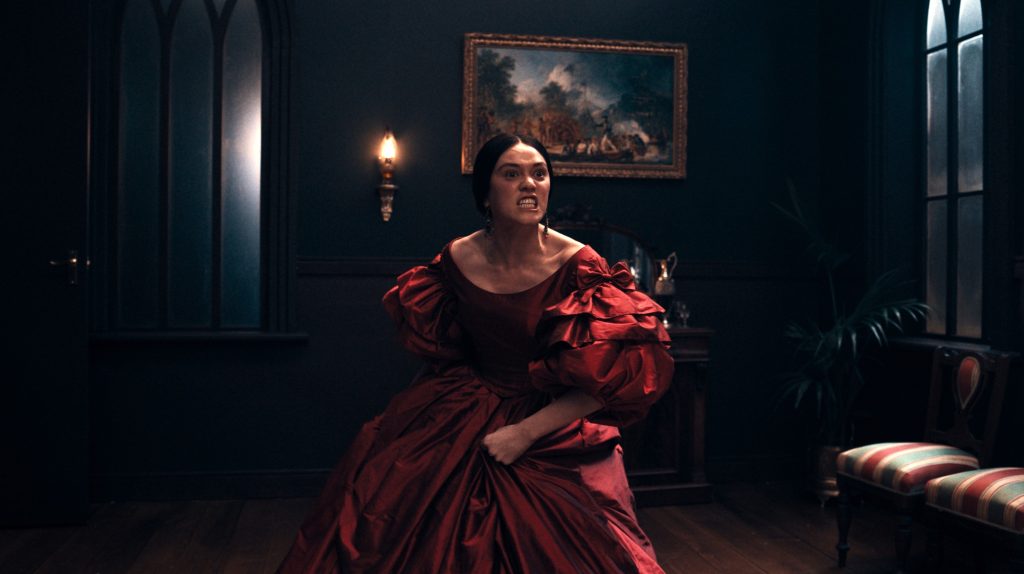Take it from the pastiest British person you know: the history of Britain is not an exclusively white history. That feels important to reiterate right now at a time when right-wing idiots are painting St. George’s flags all over England and spewing nonsense about taking “their” country back. The nation so concerned with immigration today once plunged its greedy fingers into every pocket of the world, pilfering its riches, ransacking cultures, and dragging people from their homes. Some of those people found a new home—willingly or otherwise—in the British Isles, yet they are so often left out of our history as to become invisible. Set in Victorian England, Mārama, the debut feature of writer-director Taratoa Stappard, shines a bright spotlight on the colonial scars that Britain likes to pretend are long-since healed, if it acknowledges them at all, revealing that they’re very much still bleeding.
A Warm Smile Hides a Hungry Eye
Mārama opens with a shot of a woman with fresh cuts on her chin. Anyone possessing even a passing familiarity with Māori culture will likely recognize this for what it is—not the aftermath of an attack, but an act of defiance, a freshly chiseled moko kauae tattoo. We’re then introduced to our protagonist, the eponymous Mārama (Ariāna Osborne), a young Māori woman who was given the anglicized name “Mary” by the European couple that adopted her after she was orphaned. She’s just made the arduous 73-day journey from Aotearoa to North Yorkshire, England, after receiving a letter from a man claiming to know something of her heritage.
Unfortunately, after a not-so-friendly welcome from the locals, Mārama discovers that the man who summoned her has died. With few other options, she reluctantly accepts a job offer from whaling tycoon Nathaniel Cole (Toby Stephens), who is looking for a governess for his niece, Anna (Evelyn Towersey).
The Facade of Cultural Appreciation in Mārama
Stephens initially portrays Cole as a warm and enlightened man with a deep appreciation for Mārama’s culture. He speaks the Māori language. His mansion is filled with Māori artifacts. But the warning signs are there from the start: a passing reference to the Māori people as “specimens;” a painting depicting the white man taming the “savages” on his wall. The deeper Mārama ventures into the stately home and grounds, the clearer it becomes that Cole’s proclaimed appreciation disguises appropriation in its darkest form: he takes whatever he wants, even that which is most sacred, most personal, and reduces it to mere decoration, to costume.
Stappard layers nuance into this portrait of colonial greed by contrasting Mārama’s experience with that of Cole’s servant, Peggy (Umi Myers), also a woman of color but not Māori. Peggy at first resents Mārama’s seemingly cushy existence in the house, highlighting the barriers to solidarity that can make it harder for marginalized groups to stand up to shared enemies. It’s all oppression, and of a kind that is especially heightened for women, but Cole’s fetishization of the Māori culture creates all-new avenues for objectification and harm.
Biting Back a Cry of Defiance
Osborne embues Mārama with quiet dignity and simmering rage as she navigates this perverse mirror of the culture she has been torn from. Combined with the oppressive, uneasy scoring from Karl Sölve Steven and Rob Thorne, her performance leaves the audience with a sick feeling in the pit of our stomachs. By the time we’re introduced to “Uncle Jacky” (Erroll Shand), a slimy white man with moko kanohi (Māori facial tattoos, symbolic of a person’s ancestry and achievements), we flinch at the sight right along with Mārama. We’re more than ready for her to burn the whole house down, but Stappard has more evils to unpack before granting any relief, including one devastating third-act reveal that will knock the breath out of you.
The horror in Mārama is quiet and understated, but the impact is profound. Stappard taps into staple elements of the jump scare industry as his hero experiences flashes of the terrible truth through frightening visions and dreams, but these are rarely accompanied by the typical jolting music stings. The lack of score in certain scenes leaves us to sit in our discomfort, but it also allows us to experience the full impact of Mārama’s defiance when she finally snaps and fights back, reclaiming her power and embracing her heritage. Osborne’s performance is simply transcendent, aching with pain and fury and a deep longing for everything that has been taken from her. This is “good for her” horror at its finest, and when the moment comes, it’s as cathartic as it is bittersweet.
The Perfect Evolution of Gothic Horror
Indigenous horror is still a relatively untapped well as a new generation of filmmakers fight for their seat at a table that wasn’t built with them in mind. Mārama is a shining example of all the stories that badly need to be told, and all the ways that the subgenres we love can benefit from an injection of fresh blood. The world that Stappard conjures is richly realized, with all its striking architecture and lush period costumes, inky shadows, and deep, bloody reds. It serves as a stark reminder of what Gothic horror does best: reveal that which has been repressed, forgotten but not silenced, demanding to be brought into the light.
